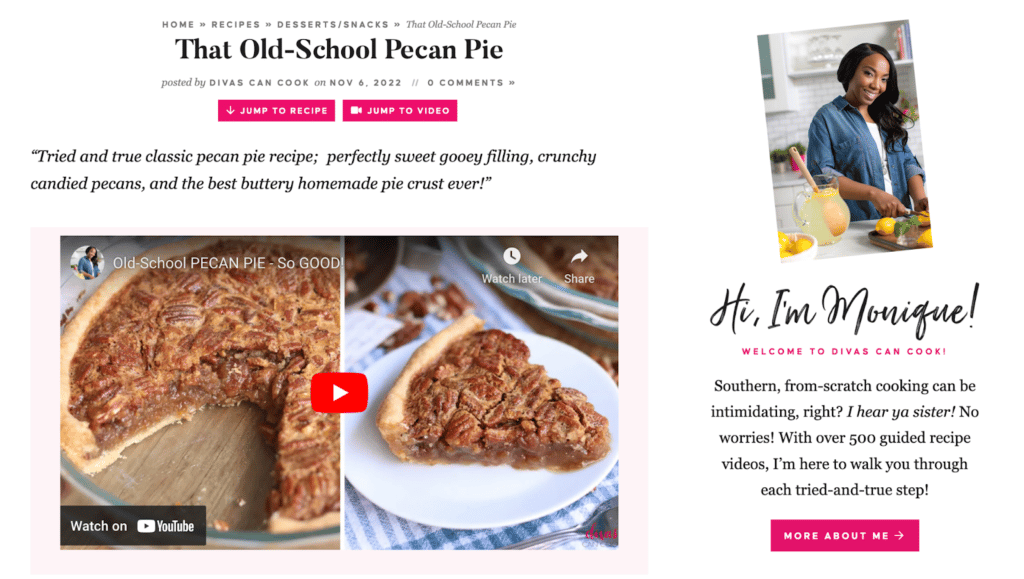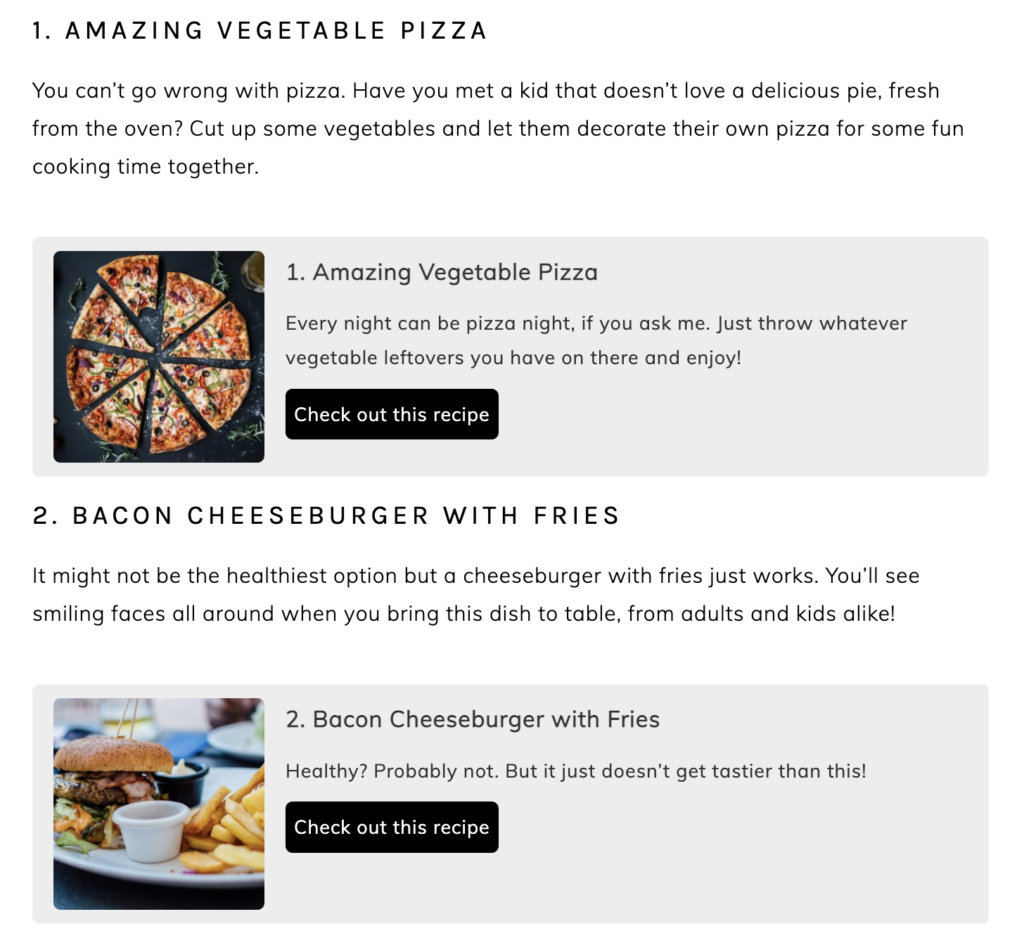Having a food blog introduction is important for your website! It sets the tone for your entire blog and gives you an opportunity to make a lasting first impression. Readers can find out more about you and why your recipes may be relevant to them.
A high-quality introduction can also help your blog rank better. According to guidelines by Google, the best way to build a high-quality, high-ranking site is to include content written by a real expert or enthusiast that knows the topic well. A good introduction page positions you as an expert and will help your site appear more genuine and substantial. All of this contributes to your food blog being picked up by search engines.
In this post, we’ll show you how to create an introduction page for your food blog using WordPress, share food blog introduction samples, and show how to customize your introduction to look more professional and stand out from other websites.
Where should you place your introduction on your food blog?
The placement of your introduction is key. It has to stand out and be easily accessible to the food lovers that visit your site.
The most obvious locations for the introduction are the Homepage and the About Us page. You might be tempted to make it for your first blog post, but as you post more and more recipes, it’s going to get lost. It’s best to place your introduction so that it forms a permanent part of your site navigation.
The best location for your introduction will depend largely on your WordPress theme. If you have a great homepage layout, that’s probably the best place for your introduction. Make sure it’s visible and obvious what people will be linking to.
Another useful tip is to link to your introduction page from your recipes. That way, if a visitor finds a recipe through Google search, they can quickly and easily find out more about you. You can link with a short sentence, for example:
- “Hi, I’m Allie! Welcome to my site. I’ve been on a journey to discover new foods since I spent the summer hiking through Europe. Read more about my food-related journey here.”
- “Thanks for visiting the Paleo baker. You can find out why I’m so passionate about healthy food on my intro page.”
Of course, your readers won’t get to know more about you unless your recipes look great! For WordPress users, the best way to do this is WP Recipe Maker, a plugin that allows you to display recipes on your website. It’s easy to use and you can customize your recipes to match your blog theme using the Template Editor.

Using the Template Editor, you can add blocks to your recipes, which means you can add a CTA that links back to your introduction page from every recipe.
You can also use the Author Links feature to set up a custom author on any recipe or add a link to the author’s name. That way, food lovers can just click on your name and go straight to your intro page.


The plugin also helps people find your recipes, as it automatically adds JSON-LD metadata to each recipe, which improves your SEO and helps you get more visitors.
WP Recipe Maker is packed with other useful features, including easy ingredient links, adjustable servings, nutrition data, ratings, unit conversion, and even recipe submission forms so your followers can send suggestions to you.
Tips for writing a great food blog introduction
Now that you know the best practices for making your food blog introduction accessible and visible to your readers, let’s discuss some helpful tips for writing your introduction. We’ll also look at a few food blog introduction samples so you can get a few ideas on how to approach yours.
Tip 1: Introduce Yourself
This may seem obvious, but your introduction is the best opportunity you’ll get to talk about yourself, who you are, and what you are all about. Using your real name and photos of yourself will humanize your blog and build rapport with your readers. If you prefer to stay anonymous, be creative about it. Come up with a character and write the blog through that persona. It will make your blog fun and can assist you with branding, e.g., “The Paleo Foodie,” “The Health Nut,” and “The Carb-Free Cook.”

Tip 2: Write about your story and credentials
Readers want to know more about you and why you’ve set up your food blog. Your story gives you credibility and lets readers know that your blog is worth their time. Are you a professional chef on a mission to make restaurant-quality recipes accessible to the general public? Are you a mom of three kids that wants to show people how to create healthier school lunches? Has cutting out carbs or going Paleo changed your life for the better? By delving into your motivation, you’re far more likely to find foodies that relate to you and want to read and share your blog with others.
Tip 3: Find your voice
Your introduction page sets the tone for the entire recipe blog, so it has to be representative of who you are and your personality. If you like to use humor or tell stories, make sure this shines through in your introduction and recipe pages, for example:
- “There are food blogs that are all about living your best life and cutting out sugar and carbs. This is not one of them. If you like butter and potatoes, you have come to the right place.”
- “For me, cooking has always been about family and gathering around the kitchen, preparing a meal, and sharing laughs and stories. In this blog, I’ll share not only some of my favorite family recipes but also our favorite family stories and anecdotes.”
It may take a while before you really find your tone of voice, but once you find it, try and be consistent with it!
Tip 4: Talk about your USP and your mission statement
There are hundreds of food blogs on the internet, so what does yours offer that others don’t? Remember, your blog isn’t just about you. It’s about how you can help or entertain your readers. When reading your introduction, your readers should understand what your USP (Unique Selling Proposition) is, and why it’s relevant to them. Here are a few examples:
- Focusing on specific recipes, e.g., low carb, Paleo, healthy recipes, Southern cooking
- Sourcing local and organic ingredients
- Writing about new foods and exotic ingredients
Writing your food blog introduction can be a great exercise in finding your niche. Remember, you don’t need to appeal to everyone. You only need to appeal to a group of like-minded foodies that understand what you are trying to accomplish.

Tip 5: Show off your best recipes
If you really want your readers to know what you are all about and what they are in for, why not use your introduction page to showcase your best recipes? These can be the most popular recipes or just the ones that are the most representative of your personal brand.
WP Recipe Maker has a great feature for that called Recipe Roundup. You can use these roundups to feature a description and link to every recipe you want to display on your introduction page. The Template editor gives you full creative control of the layout, so you can add roundups that match your blog layout.

Write your food blog introduction today!
Your introduction page sets the scene for your entire blog. We’ve provided some helpful tips and looked at food blog introduction samples to illustrate this point and hopefully provided some inspiration to get you started.
Your introduction is a great way to engage new readers, boost your SEO, and ensure that readers click on your top recipes through embedded recipe elements or links to your favorite foods.
By using WP Recipe Maker, you can link to your top recipes on your food blog introduction page, or use Blocks or Author Links to link back to your introduction on every single recipe you publish. Get WP Recipe Maker today and introduce your food blog to the world in style.






